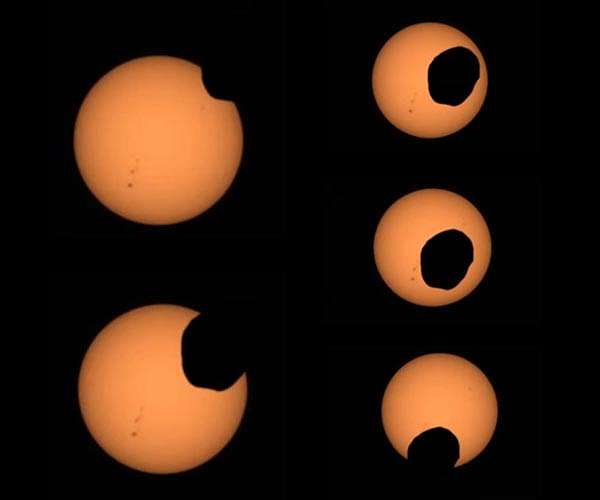
Perseverance captures video of solar eclipse on Mars (Image Credit: Space Daily)
NASA’s Perseverance Mars rover has captured dramatic footage of Phobos, Mars’ potato-shaped moon, crossing the face of the Sun. These observations can help scientists better understand the moon’s orbit and how its gravity pulls on the Martian surface, ultimately shaping the Red Planet’s crust and mantle.
Captured with Perseverance’s next-generation Mastcam-Z camera on April 2, the 397th Martian day, or sol, of the mission, the eclipse lasted a little over 40 seconds – much shorter than a typical solar eclipse involving Earth’s Moon. (Phobos is about 157 times smaller than Earth’s Moon. Mars’ other moon, Deimos, is even smaller.)
The images are the latest in a long history of NASA spacecraft capturing solar eclipses on Mars. Back in 2004, the twin NASA rovers Spirit and Opportunity took the first time-lapse photos of Phobos during a solar eclipse. Curiosity continued the trend with videos shot by its Mastcam camera system.
But Perseverance, which landed in February 2021, has provided the most zoomed-in video of a Phobos solar eclipse yet – and at the highest-frame rate ever. That’s thanks to Perseverance’s next-generation Mastcam-Z camera system, a zoomable upgrade from Curiosity’s Mastcam.
“I knew it was going to be good, but I didn’t expect it to be this amazing,” said Rachel Howson of Malin Space Science Systems in San Diego, one of the Mastcam-Z team members who operates the camera.
Howson noted that although Perseverance first sends lower-resolution thumbnails that offer a glimpse of the images to come, she was stunned by the full-resolution versions: “It feels like a birthday or holiday when they arrive. You know what’s coming, but there is still an element of surprise when you get to see the final product.”
Color also sets this version of a Phobos solar eclipse apart. Mastcam-Z has a solar filter that acts like sunglasses to reduce light intensity. “You can see details in the shape of Phobos’ shadow, like ridges and bumps on the moon’s landscape,” said Mark Lemmon, a planetary astronomer with the Space Science Institute in Boulder, Colorado, who has orchestrated most of the Phobos observations by Mars rovers. “You can also see sunspots. And it’s cool that you can see this eclipse exactly as the rover saw it from Mars.”
As Phobos circles Mars, its gravity exerts small tidal forces on the Red Planet’s interior, slightly deforming rock in the planet’s crust and mantle. These forces also slowly change Phobos’ orbit. As a result, geophysicists can use those changes to better understand how pliable the interior of Mars is, revealing more about the materials within the crust and mantle.
Scientists already know that Phobos is doomed: The moon is getting closer to the Martian surface and is destined to crash into the planet in tens of millions of years. But eclipse observations from the surface of Mars over the last two decades have also allowed scientists to refine their understanding of Phobos’ slow death spiral.
Video: NASA’s Perseverance Rover Sees Solar Eclipse on Mars
Related Links
Perseverance Mars 2020
Solar Science News at SpaceDaily
|
|
Tweet |
|
|
|
We need your help. The SpaceDaily news network continues to grow but revenues have never been harder to maintain. With the rise of Ad Blockers, and Facebook – our traditional revenue sources via quality network advertising continues to decline. And unlike so many other news sites, we don’t have a paywall – with those annoying usernames and passwords. Our news coverage takes time and effort to publish 365 days a year. If you find our news sites informative and useful then please consider becoming a regular supporter or for now make a one off contribution. |
||
|
SpaceDaily Monthly Supporter $5+ Billed Monthly |
SpaceDaily Contributor $5 Billed Once credit card or paypal |
|
Eclipse Over Texas: Live From Waco To Celebrate April 8, 2024 Total Solar Eclipse
Washington DC (SPX) Apr 08, 2022
A total solar eclipse will take place on April 8, 2024 and Texas is an ideal location for viewing this rare celestial display. Lowell Observatory is teaming with the City of Waco, Baylor University, and Discovery on a public event, Eclipse Over Texas 2024. This will include an onsite celebration at Baylor University’s McLane Stadium in Waco, as well as virtual programming that people around the world may view.
“If you missed experiencing totality during the 2017 Great American Eclipse, you have an … read more









